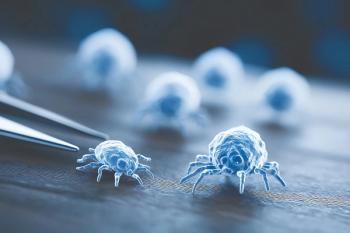
Starting from scratch on neovascular age-related macular degeneration
Key Takeaways
- Gene therapy for nAMD offers potential to reduce treatment burden and improve vision, but long-term safety and efficacy remain concerns.
- Various gene delivery systems, including lentivirus and AAV, have advantages and limitations, impacting their suitability for ocular applications.
AMD treatment may become unrecognizable as gene therapies evolve.
Luis Arias, MD; and Paolo Lanzetta, MD, recently found themselves on opposite sides of the debate table regarding the value of gene therapy to treat neovascular age-related macular degeneration (nAMD) at the 16th Annual Congress on Controversies in Ophthalmology in Seville, Spain. Arias hails from the Retina Department of Ophthalmology at Bellvitge University Hospital in Barcelona and the University of Barcelona, Spain, and Lanzetta from the Department of Ophthalmology, University of Udine, and the Istituto Europeo di Microchirurgia Oculare, both in Udine, Italy.
Arguing for the bright future of gene therapy for nAMD
Despite the recent attention to the potential of developing and using gene therapy to treat several diseases, the therapy was introduced more than half a century ago. In fact, clinical trials for ornithine transcarbamylase deficiency and X-linked severe combined immunodeficiency began in 1999 and 2002,1 respectively.
About 10 years later, the first in vivo gene therapy was approved in Europe in 2012 and the US in 2017. Ex vivo products were approved in 2016 and 2017, respectively. As of 2022, numerous future products are in the works,1 Arias noted.
He envisions a bright future for gene therapy to treat nAMD in clinical practice. “Currently, we administer many intravitreal injections of anti–vascular endothelial growth factor [VEGF] drugs over time to treat nAMD. Gene therapies are a new therapeutic modality and the culmination of decades of research,” he said, which will streamline treatment of sight-threatening disorders and, in many cases, improve vision.
Approaches to gene therapy and delivery systems
The main methods involved in gene therapy are the addition of a gene2 by which genetic material is introduced into a cell to compensate for a missing or nonfunctional gene or to produce a therapeutic protein; editing of a gene3 to alter the sequence of an endogenous gene by targeted insertion, replacement, or deletion of DNA base pairs; and the alteration of a gene4-6 by delivering genetic material to encode for an engineered RNA that recognizes and modifies a cellular RNA target.
The available gene delivery systems offer a mixed bag of pluses and minuses,7 according to Arias. The use of a lentivirus provides higher capacity, transduction in dividing and nondividing cells, and low immunogenicity, but it is hampered by low production yield, random integration, and insertional mutagenesis.
Adeno-associated virus (AAV) does not cause any known diseases, induces a low immune response, and provides long-term expression. However, the downsides are limited capacity and the fact that long-term expression can be limited to postmitotic cells; further, humans can have high immunity, with about 30% to 80% of the human population having antibodiesto AAVs.8
The most common vector used is AAV8 because it is nonpathogenic and induces a low immune response; additionally, the delivered gene remains an episome without integrating into the cell genome.
The use of adenovirus, which differs from AAV, provides a substantial transgene capacity and high transduction in dividing and nondividing cells; however, it provokes a strong immune response, and the long-term expression is limited to dividing cells.
Finally, a nonviral gene system offers a low risk of both immunogenicity and insertional mutagenesis but is hampered by lower transfection efficacy and lack of persistent gene expression.
Focus on the eye
As of 2018,9 there have been more US trials investigating gene therapy for ocular diseases than for any other bodily system. This is because of the eye’s accessibility, well-defined anatomy, immune privilege, established proof of concept with approved products, and measurable outcomes, according to Arias.
Ocular gene therapy can be administered into the subretinal space after performing a vitrectomy. Other potential routes of administration being investigated that do not require a surgical procedure are intravitreal and suprachoroidal injections.
Data from ongoing clinical trials have demonstrated that many patients with nAMD treated with gene therapy can control their disease with no supplemental injections over time. Importantly, gene therapy seems to be well tolerated and has a good safety profile. This is in contrast to the visual outcomes of patients with nAMD whose vision decreased over time despite numerous injections of anti-VEGF therapy, as seen in data from randomized controlled trials.10-13
The ABBV-RGX-314 (Regenxbio) phase 1/2a trial (NCT03066258) in subretinal nAMD tested the safety and efficacy of the treatment in previously treated patients with nAMD. Investigators evaluated 5 doses of the therapy.14
The key takeaways of the trial were as follows: ABBV-RGX-314 significantly reduced the need for anti-VEGF injections in patients with nAMD. Patients maintained stable or improved vision and retinal anatomy for up to 4 years. A study on treating the second eye in patients with bilateral wet AMD showed a 97% reduction in annualized anti-VEGF treatment burden at 9 months, with most patients being injection-free.
The treatment was generally well tolerated, with no drug-related serious adverse events reported in the fellow eye study. Mild, temporary adverse events included retinal pigmentary changes and conjunctival hemorrhage. Prophylactic steroids were not used in the fellow eye study beyond those typical for surgery.
The ATMOSPHERE (NCT04704921) and ASCENT (NCT05407636) trials, the phase 3 extension studies of ABBV-RGV-314, are ongoing and testing 2 doses of ABBV-RGC-314. These trials are evaluating the safety and tolerability of ABBV-RGV-314 compared with ranibizumab (Lucentis; Genentech, Inc) and aflibercept (Eylea; Regeneron Pharmaceuticals, Inc), respectively.
“Gene therapy has the potential to transform the lives of patients through continuous treatment for both rare and common diseases,” Arias concluded.
Arguing against gene therapy for nAMD
The introduction of anti-VEGF therapies in the early 2000s was a breakthrough in the treatment of nAMD. The MARINA (NCT00056836) and ANCHOR (NCT00061594) studies15,16 evaluated the effects of monthly injections of ranibizumab 0.5 mg. The data showed that 91% and 98% of patients, respectively, were able to maintain their vision compared with those receiving sham treatment.
After evaluating a plethora of studies of various anti-VEGF agents, investigators of the recent PULSAR study and extension trial (NCT04423718)17 found that aflibercept 8 mg improved treatment outcomes and provided sustained disease control in patients with nAMD with extended dosing compared with aflibercept 2 mg.
The technology behind anti-VEGF drugs has evolved markedly from the initial results that prevented significant losses of vision to the present, when patients can gain vision with the initiation of treatment. The future holds promise for a reduced treatment burden with preservation of vision and/or gains.18
Gene therapy delivery considerations
Regarding gene therapy, Lanzetta sees a place for it, but stresses that now is not the time to adopt the technology as the standard of care because there are still too many unknowns.
He suggested that introducing gene therapy into the suprachoroidal space, rather than subretinally or intravitreally, is a feasible and efficacious route that is more acceptable because of the targeted access and broad transduction of the retinal cells observed in preclinical studies, compartmentalized AAV delivery, and minimal exposure to the vitreous and anterior segment. In addition, suprachoroidal delivery can be performed in an office setting.
He cited the phase 2 AAVIATE trial (NCT04514653) of ABBV-RGX-31419 in which the treatment was injected via the suprachoroidal route, in contrast to the previously mentioned subretinal route. In this dose-escalation study that included 116 patients, the key outcomes were best corrected visual acuity, ABBV-RGX-314’s safety and tolerability, central retinal thickness, and need for additional anti-VEGF injections. An analysis of 3 doses tested showed that the treatment was well tolerated. The highest dose resulted in the greatest reduction in treatment burden, with an 80% reduction in annualized injection rate and 50% of eyes being injection-free. No intraocular inflammation developed in cases treated with a short course of prophylactic topical steroid eye drops.
Although good results are being obtained, the appropriate dose has not been determined. Lanzetta explained that some patients likely lost vision because they received an incorrect dose, and some need anti-VEGF injections.
Ixo-vec (ixoberogene soroparvovec; Adverum Biotechnologies), formerly ADVM-022, is an AAV gene therapy that uses a vector capsid, AAV.7m8, which delivers aflibercept to the retina. Data from various studies have shown that the vision and central subfield thickness were maintained through 4 years, and the treatment burden was reduced, but almost 50% of patients needed additional injection,20 Lanzetta noted.
4D-150 (4D Molecular Therapeutics) is an intravitreally delivered gene therapy that aims to produce aflibercept in the eye, promote its expression, and inhibit VEGF-C. The treatment provides sustained improvement in vision without fluctuations. Approximately 57% of patients were injection free; 83% enjoyed a reduced treatment burden. No serious adverse effects developed.21
Lanzetta countered the proponents of gene therapy for nAMD. “Viral vector gene therapy delivery is not the best choice. While the technology has enabled the first generation of commercialized gene therapy products, the next-generation therapies will require more complex engineering, including multiple gene edits that will require a nonviral solution. The biggest industrial limitations with the viral vector approach are space in the viral capsid, cost, and inflexibility in manufacturing.” Alternatives to viral vector gene therapy are available and include delivering genetic material to the cells via lipid nanoparticles, delivering DNA to tissues via electric currents, and plasmid-based gene therapy.
New technology
A new approach is laser-assisted optoporation, a nonviral gene delivery and expression of opsin- encoding genes in mouse retina in vitro and in vivo by use of pulsed femtosecond laser microbeam.22
Lanzetta concluded, “Subretinal viral vector gene therapy delivery of anti-VEGF is not a viable therapeutic strategy for the management of retinal diseases.” He cited the following in his argument:
Viral vector–based gene delivery “remains a rudimentary and constrained technology, with issues related to immunogenicity, vector capacity, and manufacturing.”
Subretinal administration is “invasive, requiring vitrectomy and retinotomy, with gene expression confined to the area of the bleb.”
VEGF inhibition alone may be insufficient to address the complex pathophysiology of retinal diseases such as nAMD, particularly via a single transgene product.
Continuous, irreversible VEGF suppression “raises concerns for long-term ocular and systemic safety, including risks of RPE [retinal pigment epithelium] atrophy and treatment-related adverse effects.”
Gene therapy cannot be halted, modified, or reversed, even in the event of complications or lack of efficacy.
Luis Arias, MD
Arias reported being on the advisory board of AbbVie, and he lectures on behalf of the company.
Paolo Lanzetta, MD
Lanzetta is with the Department of Ophthalmology, Istituto Europeo di Microchirurgia Oculare (IEMO) in Udine, Italy. He reported being a consultant for Adverum, Aerie, Allergan, Annexon, Apellis, Bausch + Lomb, Bayer, Biogen, Boehringer Ingelheim, EyeBio, EyePoint, i-Care, Genentech, Novartis, Ocular Therapeutix, Outlook Therapeutics, and Roche.
References
Arabi F, Mansouri V, Ahmadbeigi N. Gene therapy clinical trials, where do we go? an overview. Biomed Pharmacother. 2022;153:113324. doi:10.1016/j.biopha.2022.113324
Petrich J, Marchese D, Jenkins C, Storey M, Blind J. Gene replacement therapy: a primer for the health-system pharmacist. J Pharm Pract. 2020;33(6):846-855. doi:10.1177/0897190019854962
Maeder ML, Gersbach CA. Genome-editing technologies for gene and cell therapy. Mol Ther. 2016;24(3):430-446. doi:10.1038/mt.2016.10
Adachi H, Hengesbach M, Yu YT, Morais P. From antisense RNA to RNA modification: therapeutic potential of RNA-based technologies. Biomedicines. 2021;9(5):550. doi:10.3390/biomedicines9050550
Lam JKW, Chow MYT, Zhang Y, Leung SWS. siRNA versus miRNA as therapeutics for gene silencing. Mol Ther Nucleic Acids. 2015;4(9):e252. doi:10.1038/mtna.2015.23
Berger A, Maire S, Gaillard MC, Sahel JA, Hantraye P, Bemelmans AP. mRNA trans-splicing in gene therapy for genetic diseases. Wiley Interdiscip Rev RNA. 2016;7(4):487-498. doi:10.1002/wrna.1347
Rodrigues GA, Shalaev E, Karami TK, Cunningham J, Slater NKH, Rivers HM. Pharmaceutical development of AAV-based gene therapy products for the eye. Pharm Res. 2018;36(2):29. doi:10.1007/s11095-018-2554-7
Calcedo R, Vandenberghe LH, Gao G, Lin J, Wilson JM. Worldwide epidemiology of neutralizing antibodies to adeno-associated viruses. J Infect Dis. 2009;199(3):381-390. doi:10.1086/595830
Wang D, Tai PWL, Gao G. Adeno-associated virus vector as a platform for gene therapy delivery. Nat Rev Drug Discov. 2019;18(5):358-378. doi:10.1038/s41573-019-0012-9
Singer MA, Awh CC, Sadda S, et al. HORIZON: an open-label extension trial of ranibizumab for choroidal neovascularization secondary to age-related macular degeneration. Ophthalmology. 2012;119(6):1175-1183. doi:10.1016/j.ophtha.2011.12.016
Rofagha S, Bhisitkul RB, Boyer DS, Sadda SR, Zhang K; SEVEN-UP Study Group. Seven-year outcomes in ranibizumab-treated patients in ANCHOR, MARINA, and HORIZON: a multicenter cohort study (SEVEN-UP). Ophthalmology. 2013;120(11):2292-2299. doi:10.1016/j.ophtha.2013.03.046
Maguire MG, Martin DF, Ying G-S, et al. Five-year outcomes with anti-vascular endothelial growth factor treatment of neovascular age-related macular degeneration: the comparison of age-related macular degeneration treatments trials. Ophthalmology. 2016;123:1751-61. doi: 10.1016/j.ophtha.2016.03.045.
Ciulla TA, Hussain RM, Taraborelli D, Pollack JS, Williams DF. Longer-term anti-VEGF therapy outcomes in neovascular age-related macular degeneration, diabetic macular edema, and vein occlusion-related macular edema: clinical outcomes in 130 247 eyes. Ophthalmol Retina. 2022;6(9):796-806. doi:10.1016/j.oret.2022.03.021
Campochiaro PA, Avery R, Brown DM, et al. Gene therapy for neovascular age-related macular degeneration by subretinal delivery of RGX-314: a phase 1/2a dose-escalation study. Lancet. 2024;403(10436):1563-1573. doi:10.1016/S0140-6736(24)00310-6
Rosenfeld PJ, Brown DM, Heier JS, et al; MARINA Study Group. Ranibizumab for neovascular age-related macular degeneration. N Engl J Med. 2006;355(14):1419-1431. doi:10.1056/NEJMoa054481
Brown DM, Kaiser PK, Michels M, et al; ANCHOR Study Group. Ranibizumab versus verteporfin for neovascular age-related macular degeneration. N Engl J Med. 2006;355(14):1432-1444. doi:10.1056/NEJMoa062655
Wong TY. Three-year outcomes of aflibercept 8 mg in nAMD: safety and efficacy results from the PULSAR Extension study. Presented at: Angiogenesis, Exudation, and Degeneration 2025; February 8, 2025; Virtual.
Corporate presentation. Adverum. March 2024. Accessed July 9, 2025. https://s29.q4cdn.com/232311837/files/doc_presentations/2024/Mar/04/adverum-corporate-presentation-march-2024_website.pdf
Suprachoroidal delivery of investigational ABBV-RGX-314 for neovascular AMD: results from the phase II AAVIATE study. Regenxbio. January 16, 2024. Accessed July 9, 2025. https://ir.regenxbio.com/static-files/6103706d-0d60-4e3d-bc2b-278a85c50221
Preserving sight for life. Adverum. March 2025. Accessed July 9, 2025. https://s29.q4cdn.com/232311837/files/doc_presentations/2025/Mar/01/Adverum-Corporate-Presentation-March-2025.pdf
Khanani AM. Retina Round-up: Arshad M. Khanani. The Ophthalmologist. December 11, 2024. Accessed September 29, 2025. https://theophthalmologist.com/issues/2024/articles/dec/retina-round-up-arshad-m-khanani
Batabyal S, Kim S, Wright W, Mohanty S. Laser-assisted targeted gene delivery to degenerated retina improves retinal function. J Biophotonics. 2021;14(1):e202000234. doi:10.1002/jbio.202000234
Newsletter
Don’t miss out—get Ophthalmology Times updates on the latest clinical advancements and expert interviews, straight to your inbox.








































